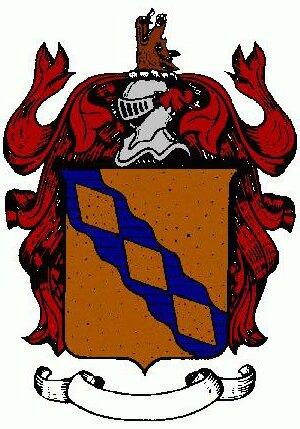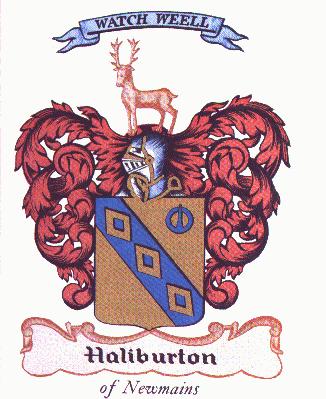PETE'S PLACE: GENEALOGY - HALIBURTON COAT OF ARMS
HALIBURTON COAT OF ARMS
 Coats of Arms were a method developed by knights to identify each other while in battle. They would paint an emblem on their sheild and embroider it on their surcoats. These crests were permitted to be used by the family of the knight, and often the medieval battle cry became the family motto.
Coats of Arms were a method developed by knights to identify each other while in battle. They would paint an emblem on their sheild and embroider it on their surcoats. These crests were permitted to be used by the family of the knight, and often the medieval battle cry became the family motto.
The Haliburton Coat of Arms is made up of a gold shield with a left slanted blue line. On the line are three gold diamonds. This description has become the basis for some variation.
The illustration on the left (a lineart image I scaned and colored) was derived from an official description documented in Burke's General Armory. This is how the language developed by heraldic artists puts it: "Or, on a bend wavy az. three lozenges of the first. A boar's head couped and erect ppr." The motto listed in the book was "MAJORES SEQUOR" or "I Follow Our Ancestors".

 The illustration on the right is a scan from the cover of Donald N. Haliburton's book, Watch Weell/Haliburtons of New Zealand and Their Scottish Forebears. His Coat of Arms ". . .shows a stag at gaze, with the family motto, 'Watch Weell', above". He does not include any meaning for the motto, but he does point out the similarity to the shield found on Lord John Haliburton's headstone [NOTE: Click on the small image to display the full memorial] and those used by the both Coats of Arms.
The illustration on the right is a scan from the cover of Donald N. Haliburton's book, Watch Weell/Haliburtons of New Zealand and Their Scottish Forebears. His Coat of Arms ". . .shows a stag at gaze, with the family motto, 'Watch Weell', above". He does not include any meaning for the motto, but he does point out the similarity to the shield found on Lord John Haliburton's headstone [NOTE: Click on the small image to display the full memorial] and those used by the both Coats of Arms.
The actual Haliburton Coat of Arms and family motto may be one, none, or both of them. The only consistant things are the shield coloring and the three diamonds. The differences could be attributed to different family members or an evolution of the crest. Perhaps further research will provide more information.
The tartan you should be seeing on the background of this page belongs to the Home/Hume clan of which Haliburton is a Sept (considered a member of). There are a couple variations of it that you can see by visiting this link.



Written 1995/11/28. Last updated on 1999/06/28
 Coats of Arms were a method developed by knights to identify each other while in battle. They would paint an emblem on their sheild and embroider it on their surcoats. These crests were permitted to be used by the family of the knight, and often the medieval battle cry became the family motto.
Coats of Arms were a method developed by knights to identify each other while in battle. They would paint an emblem on their sheild and embroider it on their surcoats. These crests were permitted to be used by the family of the knight, and often the medieval battle cry became the family motto.




